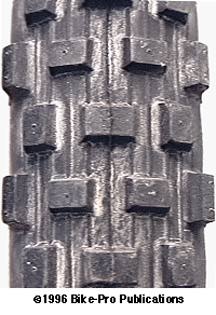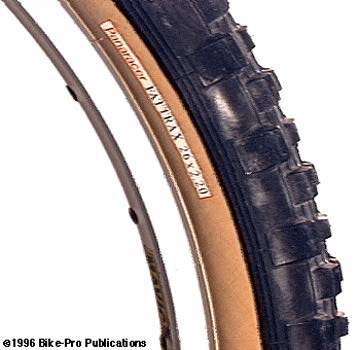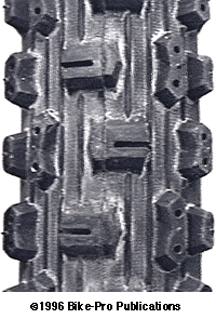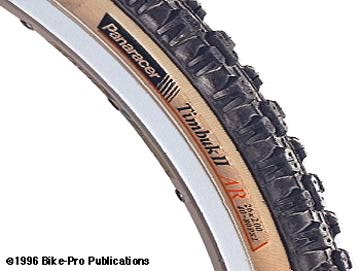Brake Systems
- Brake/Shift Levers
- Caliper Brakes (Road)
- Cantilever Brakes (MTB)
- Brake Levers
- Brake Shifter Combination Levers
- Brake Boosters
- Brake Cables
- Brake Carriers
- Brake Hangers
- Brake Pads
- Titanium Brake Hardware
Computers
Cranks and Chainrings
Forks
Frames & Framesets
Freewheels and Cassettes
Front Derailleurs
Grips
Handlebars
Handlebar Extensions
Headsets
Helmets
Hubs and Skewers
Lubricants
Metal Guide - Bicycle Metallurgy
Mirrors
Pedals and Toe Clips
Pumps and Inflation Systems
Racks
Rear Derailleurs
Rims & Rimstrips
Saddles
Seatposts and Binder Bolts
SRP Replacement Titanium &
Aluminum parts - Master Index
Stems
Tires
Tubes
Shoes
Spokes (Tables Only)
Tools - Bicycle Repair Tools
Yakima Fit List -to fit all cars
Notes
Links
Home
Panaracer Tires


PANARACER FATTRAX
The Fattrax is made by the National Tire Co. in Japan and sold under their brand name "Panaracer". The tire has a steel wire bead and comes in a Skin sidewall only. The tire tread pattern uses rectangular shaped blocks in two rows. In the center a 9mm x 11mm block rests horizontally on the centerline. To the right and left of this block is a 7mm x 11mm rectangular block placed vertically. The second half of this tread pattern is a row 1/2" from the center block made of two 8mm x 10mm rectangular blocks placed horizontally, each beginning 5mm from the tire centerline. 10mm from these two blocks on their outer sides are two edge blocks that are 5mm by 13mm placed vertically. These edge blocks have supports that rise from the sidewall adding to their rigidity. Underlying the tread pattern around the entire tire are ten raised ribs, intended to flex in use and help break away caked mud. We found the tread rubber had a hardness of 71/A. When it was still being made, we sold the Fattrax for $19.99


PANARACER TIMBUK II
The Timbuk II is made in Japan by National Tire Co. and sold under their Panaracer brand name. We sell the tire only in a steel wire bead and only in a Skin sidewall. It is directional with arrows molded into the sidewall suggesting the correct direct of revolution. The tread pattern is made of two rows of blocks, with the second row being a reversed, mirror image, of the first. Near the center is a roughly 12mm by 12mm block in a U-shape on its side. The base of the U rests on the tire centerline leaving the majority of the block offset on one side. We will describe the row of blocks with the U opening facing right. To the right of the "U" center block is an edge block, placed vertically, that's about 6mm by 15mm with angular edges and two 2mm holes centered at the top and bottom of the block. Left of the U-shaped block is a vertically placed block 6mm by 20mm, again with angular sides and two 2mm holes at the top and the bottom. Left of this, is a small 5mm by 12mm vertically placed the edge block. This edge block has supports rising from the sidewall. This block pattern is repeated in reverse for the next row, with the two rows continually repeated around the tire. Underlying the tread pattern around the entire tire are nine raised ribs, intended to flex in use and help break away caked mud. Because the tread repeats while merely reversing the block pattern it's difficult to understand why there is a directional arrow, mounting this either way wouldn't bring the slightest difference because the blocks would still roll identically. We found the tread rubber had a hardness of 72/A. When it was still being made, we sold the Timbuk II for $18.99

